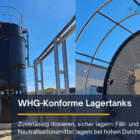Discharge refers to the controlled removal of water or wastewater from a system, be it a natural body of water, a drainage facility or an industrial water treatment or wastewater treatment plant. In technical systems, discharge is a decisive parameter for the management of water and wastewater volumes, as it influences both the hydraulic capacity and the efficiency of wastewater treatment.
Table of contents
Technical background
In industrial water and wastewater treatment, discharge plays a central role in the design and operation of pipelines, pump systems, sewer systems and treatment basins. Discharge can be by gravity or by pumping, depending on the local conditions and system design. It is measured in cubic meters per hour (m³/h) or liters per second (L/s) and ensures that the water or wastewater is continuously and regulated through the system.
Types of discharge
Natural runoff: Natural runoff occurs in bodies of water such as rivers, lakes and streams, where the water flows away under the influence of gravity. In water management, natural runoff is used to regulate excess water from precipitation or groundwater. In industry, it can be used to safely discharge purified water into public waters.
Industrial discharge: In industrial water and wastewater technology, discharge refers to the controlled removal of treated wastewater or process water from the treatment facility. This discharge takes place into wastewater pipes, collecting basins or directly into natural bodies of water. Industrial discharge is often subject to strict legal requirements regarding water quality and quantity.
Hydraulic discharge in wastewater treatment plants: In wastewater treatment plants, discharge refers to the volume of water that reaches the outlet after pre-, main and secondary treatment and is possibly discharged further into the public sewer system or into a body of water. The discharge must be precisely controlled here in order to avoid hydraulic overloads in the clarifiers and pumping stations.
Overflow discharge: An overflow discharge occurs when the wastewater system is overloaded, e.g. during heavy rain or flooding, and is no longer able to absorb the entire volume of water. Excess water is discharged in a controlled manner by overflow systems to prevent damage to the drainage system. This emergency drainage is often discharged into receiving waters or rainwater overflow basins.
Significance for the design of water and wastewater systems
The precise calculation and control of the discharge is crucial for the design of water and wastewater treatment systems, as the hydraulic load on the system is controlled via the discharge. The following aspects must be taken into account during planning and design:
Dimensioning of pipes and pumps: The capacity of the discharge determines the design of the pipes and pump systems in a system. With high discharge volumes, the pipe cross-sections must be larger and the pumps must be dimensioned more efficiently to ensure smooth transportation of the water. If the discharge capacity is too low, there is a risk of backwater, which impairs the operation of the system.
Hydraulic loading of clarifiers: In clarifiers and reactors, the discharge must only be high enough to ensure sufficient retention time for the wastewater. This is necessary so that the microorganisms have sufficient time to break down the organic impurities and physical processes such as sedimentation or filtration can take place effectively. Hydraulic overloading due to excessive discharge reduces the cleaning performance of the system.
Discharge control and monitoring: In industrial wastewater systems, flow measurements and discharge controls are crucial to ensure that the discharge meets the specified requirements. This includes both the hydraulic volume and compliance with permissible pollutant concentrations. Control valves, pump controllers and flow meters are used to monitor and control the discharge in real time.
Overflow capacities and emergency management: In systems with unpredictable or highly fluctuating water volumes, such as in the food industry, overflow capacities must be available for emergencies in order to divert water masses that occur during peak loads. Emergency overflows and retention systems play an important role here to protect the main system from overloading.
Conclusion
Discharge is a decisive parameter in water and wastewater technology that has a major impact on the design and operation of systems. It influences the dimensioning of pipes, pumps and basins and ensures that the quantity and quality of water is directed through the system in a controlled manner. Controlling the discharge is crucial for the efficiency and operational safety of water treatment and wastewater treatment plants. Precise monitoring and control of the discharge ensures compliance with environmental regulations and the functionality of the system.








